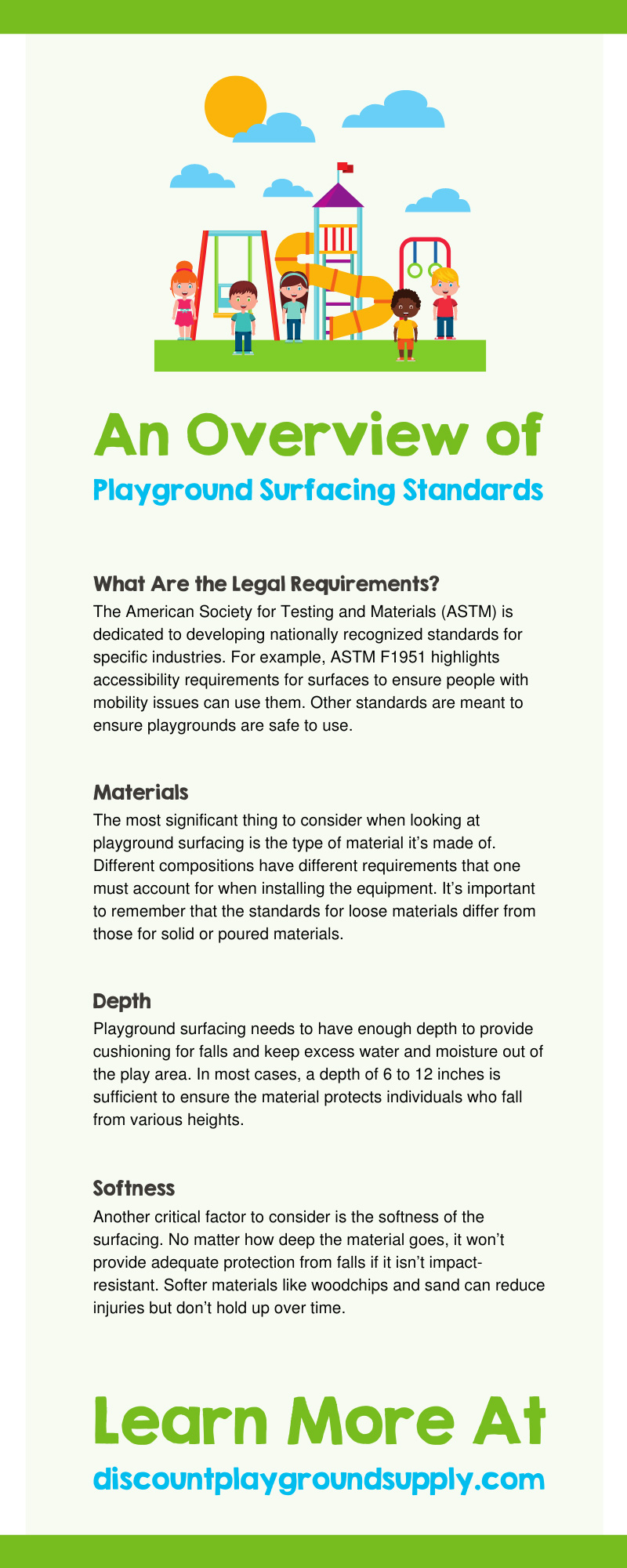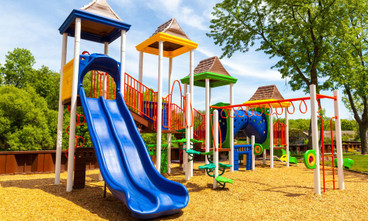A playground’s surfacing may not be the first thing you think about when it comes to safety. However, the type of material, its quality, and routine maintenance play essential roles in the overall safety of the installation.
Ensuring there’s enough space between equipment and buildings with soft materials can only do so much. Playground surfacing can reduce injuries from falling, tripping, and other accidents. Here’s an overview of playground surfacing standards so you can keep kids safe while maximizing their playtime.
What Are the Legal Requirements?
The American Society for Testing and Materials (ASTM) is dedicated to developing nationally recognized standards for specific industries. For example, ASTM F1951 highlights accessibility requirements for surfaces to ensure people with mobility issues can use them. Other standards are meant to ensure playgrounds are safe to use.
ASTM F1487-21 addresses the performance and safety requirements of playground equipment to ensure it fulfills its intended purpose. ASTM standard F1292 is associated with the safety of playground surfacing materials and how well they protect children from head injuries when they fall from certain heights. Understanding the ins and outs of surfacing requirements is essential for communities and private playground owners to reduce injuries from falls and other accidents.
Materials
The most significant thing to consider when looking at playground surfacing is the type of material it’s made of. Different compositions have different requirements that one must account for when installing the equipment. It’s important to remember that the standards for loose materials differ from those for solid or poured materials.
Gravel, woodchips, and sand are cheap options but must be replaced regularly for maximum safety. Concrete and metal last longer, but they don’t afford the same protection. This issue makes the safest option for most spaces poured rubber playground flooring since it’s resilient but still soft enough to cushion falls.
Depth
Playground surfacing needs to have enough depth to provide cushioning for falls and keep excess water and moisture out of the play area. In most cases, a depth of 6 to 12 inches is sufficient to ensure the material protects individuals who fall from various heights.
Different materials will require different depths, so it’s essential to understand what you’re working with. Every playground is different, so you’ll need to have a plan in place to ensure maximum safety. You should prioritize the area directly around playground equipment because that’s where kids will most likely fall from.
Softness
Another critical factor to consider is the softness of the surfacing. No matter how deep the material goes, it won’t provide adequate protection from falls if it isn’t impact-resistant. Softer materials like woodchips and sand can reduce injuries but don’t hold up over time.
Finding something durable and cushioned will reduce injuries and expenses, making the playground easier to maintain. Rubber surfaces offer maximum stability and softness, giving playgrounds a longer life span while ensuring their users are as safe as possible during play.
Impact Resistance
Like softness, impact resistance refers to a surface’s ability to withstand excess pressure without giving in. ASTM 1292 is mainly concerned with reducing the danger of head trauma. If a playground surface becomes cracked or displaced, it won’t offer adequate protection from falls and other injuries.
Materials capable of absorbing shocks are much more helpful for playgrounds since they can withstand heavy use. Unitary surfacing, such as poured rubber, tends to be much more resistant to impact, allowing children to have fun without putting themselves at risk.
Fall Height
The height of playground equipment plays a significant role in determining how dangerous a fall can be. Surfacing standards must account for these metrics so that the material prevents injuries from falls. ASTM F3313 provides guidance for playground operators who want to ensure maximum safety.
Equipment should never be installed higher than 10 feet off the ground. Operators must test the surfacing to ensure it can withstand the impact. If a new installation goes above the original fall height of the equipment, it must be tested before being opened to the public.
Accessibility
An often-overlooked standard for playground surfacing relates to the accessibility of the equipment. The Americans with Disabilities Act (ADA) outlines specific requirements for placing a playground surface in place.
All playgrounds must offer navigable paths that aren’t obstructed or difficult to use. They must offer access to the parking lot or building so that individuals with mobility issues can get around freely. Paths should be at least 60 inches wide and have a grade of no more than 1:50.
Degradation
As playground surfacing is used, it can become worn out, making it less safe for children. It’s essential to understand how well playground surfacing stands up to natural erosion and degradation from the elements so that you can take the necessary steps to make it last.
Dust, dirt, and debris can quickly reduce the quality of surfacing, making it easier for children to trip or fall while playing. Keeping the area clean and litter-free improves community health while reducing the wear and tear that the playground surfacing receives.
Manufacturing Process
Another thing to consider when looking at surfacing standards is the process used to create the material. A rigorous manufacturing and testing process can significantly improve the viability of surfacing before installation. Molding and shaping items into safe end-products requires understanding their intrinsic properties and how to take advantage of them.
While materials such as sand, gravel, and concrete don’t require much additional work, rubber surfacing must go through a milling process that includes preparing, mixing, injecting, and compressing raw materials. The material can then be poured on the ground to create a level surface free of cracks or impurities.
Maintain Safety Standards at All Times
Whether your playground is for the community or privately owned, it’s essential to reduce the risk of injury to users. By following surfacing standards and requirements, you can take the guesswork out of the process.
This overview of playground surfacing standards gives you a solid place to improve your installation. While it takes hard work and effort, you can make a big difference in children’s lives by protecting them from unintended spills and falls.


